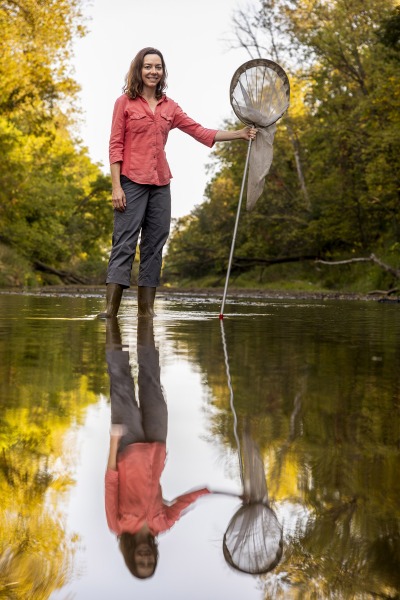Evolution, Art, and the Jewelwing Damselfly
Exploring Darwin’s ‘mystery of mysteries’
Willow Creek meanders through Grinnell’s Conard Environmental Research Area on its way to Perry Pond and eventually the Skunk River. Today — a warm, sunny day in late summer — the river flows past CERA’s woodlands and prairie remnants in a leisurely fashion.
It’s a perfect day to observe jewelwing damselflies darting through the air above the stream.
Associate Professor of Biology Idelle Cooper ’01 leads a group of students as they walk through the shallow water, wearing hats and waders and carrying nets. They’re looking for jewelwing damselflies.
For Cooper, the insects are fascinating. “They have these courtship dances and male territory fights, and some really elaborate behaviors,” she says. “It’s so fun to just stand in the stream and watch these little insects that are so agile and colorful, doing all sorts of behaviors.”
From Student to Teacher
Twenty-some years ago, Cooper was a Grinnell student, following Professor Jackie Brown on a similar expedition at CERA.
“It was such a great experience being a student at a liberal arts college — that became my ideal for how education should be,” Cooper says. She took several of Brown’s courses and later collaborated with him on research. He taught Cooper how to do fieldwork, how to see diversity and variation, and how to ask questions about the world — in short, how to be a scientist.
But Cooper is also an artist. She completed a double major in art and biology at Grinnell, which Cooper says turned out to be the perfect combination for her study of color variation in the jewelwing damselfly. “Recognizing variation, and then thinking about how to quantify it — actually, it’s really helped a lot to have an art background,” she says.
“I think it was a good way to learn how to see things and to look for patterns,” Cooper adds. “That’s the same process that’s used in research — seeing the world in a different way, looking for patterns, and identifying fundamental principles that help explain it.”
Even after graduating from Grinnell, earning a Ph.D. at Indiana University-Bloomington, and accepting a faculty position at James Madison University, Cooper continued to collaborate with Brown. Now she’s back at Grinnell College where she is a new faculty member in the Department of Biology, hoping to give her own students similar eye-opening experiences.
“I gained so much, and I hope that I can transmit that to students in the way it was provided to me,” she says. “I think it’s so great for students to see how they can be scientists, too.”
In Search of the Jewelwing Damselfly
Cooper brought a grant of almost $450,000 from the National Science Foundation (DEB-2242987) with her to Grinnell. The grant supports her project, “RUI: Conflicting selection pressures within mate choice of jewelwing damselflies.”
It’s a subject that continues to captivate her.
Cooper’s project addresses a fundamental question in evolution — how mate choice affects the way different species arise and are maintained. “Darwin described the process of a new species evolving as the ‘mystery of mysteries’ more than 150 years ago, and we still have a lot of questions,” Cooper says. “Even though there’s so much that’s been discovered, there are still a lot of questions about this fundamental process of nature.”
Cooper and her students will conduct fieldwork in Michigan, Ontario, and Iowa. They will also collaborate on an art exhibition titled Tangled Banks, focusing on the experience of studying damselflies in river environments, forging connections to nearby Indigenous tribes, exploring the role of art in the teaching of science, and identifying art’s potential to make this process of discovery even more accessible.
Think Like a Scientist
Cooper explains that students can ask some of the same fundamental questions and employ the same scientific approaches used by more experienced researchers. “Maybe they can make some discoveries that no one else has figured out yet,” she says.
By no means is this science a settled subject, Cooper says. “And that’s wonderful, because that means we can discover so much.”
It’s a hands-on way of teaching science that asks students to think like scientists. “It’s how I was taught,” she says. “I think it’s so great for students to see how they can be scientists, too.”



